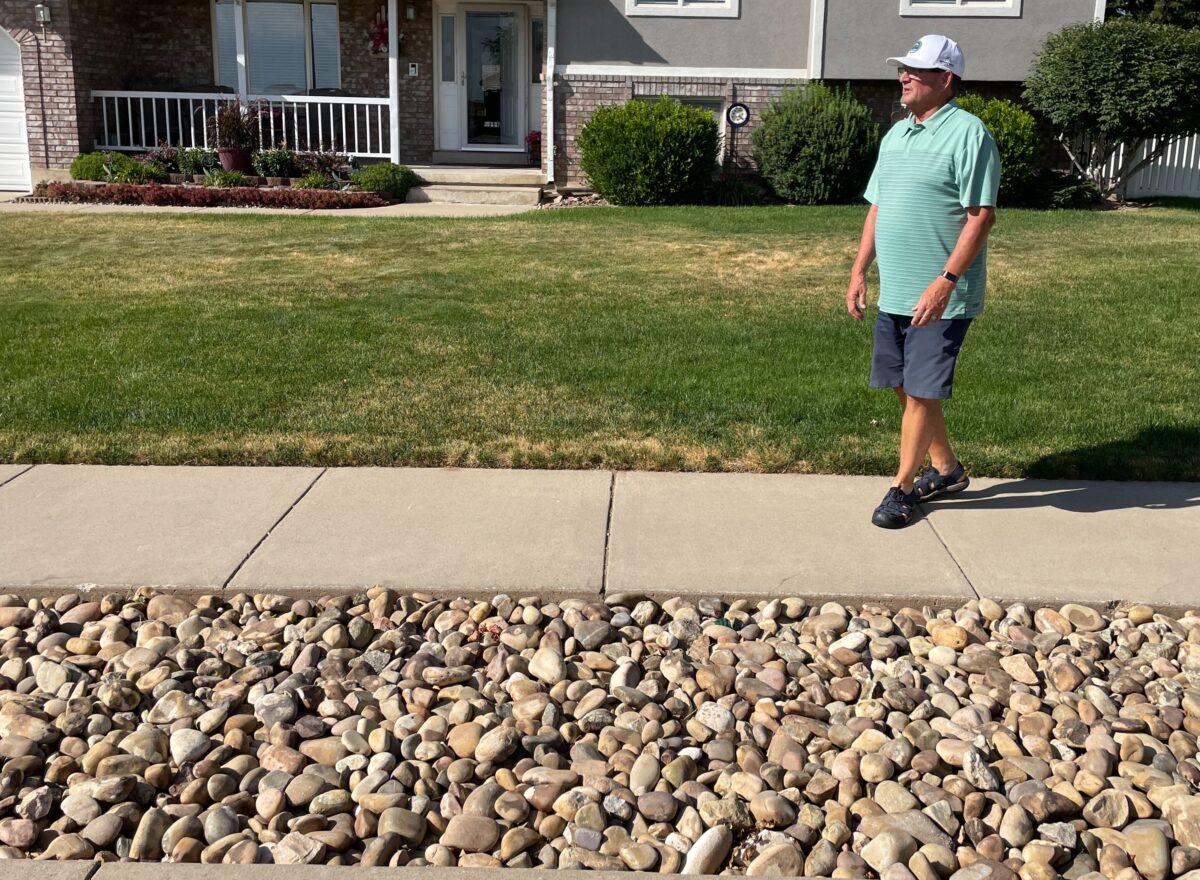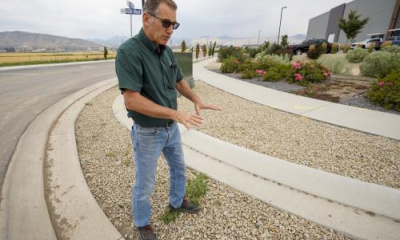WASHINGTON TERRACE — As the drought lingers, threatening the availability of water for generations to come and the future of the Great Salt Lake, Washington Terrace Mayor Mark Allen is starting to notice something.
He recently replaced the grassy area fronting his home with rocks, thus reducing the area he needs to water, and he’s seeing more and more of that around him. “You can see throughout our neighborhood — lots and lots of people are doing it,” he said.
In neighboring South Ogden, Matt Dixon, the city manager, is seeing the same thing. “Anecdotally, I know as I drive around South Ogden, there are a lot of park strips being ripped out,” he said.
As Utahns grapple with the ongoing drought, at least one tool in the toolbox of fixes seems to be gaining traction — replacement of grassy park strips with more drought-resistant vegetation and/or rocks, tempering the need for irrigation water. The Weber Basin Water Conservancy District, a water supplier in Weber, Davis, Morgan, Summit and Box Elder counties, launched a program last summer meant to encourage such conversions, Flip Your Strip. Jon Parry, assistant general manager of the entity, says more and more cities are joining the initiative.
“It has grown substantially and continues to grow every month,” he said. Through the program — tapped by Allen, the Washington Terrace mayor — the conservancy district provides participants with $1.25 per square foot of turf grass removed, with payouts averaging $600-$700 per applicant.
Though the aim is to reduce water use as supplies dwindle, there are broader possible ripple effects. Much of the water used in Northern Utah comes from flows that eventually feed into the ever-declining Great Salt Lake. Tempering human water use via efforts like Flip Your Strip can potentially increase the amount of water making its way to the lake, helping counter its historic slide.
At least 14 cities in Weber and Davis counties are participating in the program, including Washington Terrace, South Ogden, Riverdale, Layton, South Weber and Clearfield. On July 5, officials in Roy and Ogden approved changes to their landscaping ordinances enabling residents in the locales to take part as well, even if they aren’t conservancy district customers. All told, Parry said, the conservancy district had received 1,044 applications as of early July to take part in Flip Your Strip, representing about 11 acres of lawn space that would be converted.
To be sure, programs like Flip Your Strip aren’t single-handedly going to counter the drought or increase water levels in the Pineview Reservoir and other water bodies that feed the Great Salt Lake. The Jordan Valley Water Conservancy District in Salt Lake County also operates a Flip Your Strip program and they’re common in Southern California and Nevada.
“There’s no silver bullet to it. Everybody has to do a little bit,” said Ogden Mayor Mike Caldwell, addressing the launch of Flip Your Strip in his city, spurred in part by critically low levels at Pineview Reservoir. The city is matching the $1.25-per-square-foot incentive offered to Flip Your Strip participants by the Weber Basin Water Conservancy District, resulting in payouts to Ogden participants of $2.50 per square foot of grass that’s removed.
But Parry noted that 70% of household water use, on average, goes to lawns, thus scaling back on irrigation of grass has an impact. He estimates households converting park strips to vegetation requiring minimal watering could save 5,000-8,000 gallons of water a year. Beyond that, he said the conservancy district eventually hopes to expand the program to larger yard sections, not just park strips, the grassy area between the curb and sidewalk in front of a home.
Notably, Flip Your Strip also requires that participating cities implement ordinances meant to reduce areas with water-guzzling turf in future development. Thus the impact isn’t only from homeowners who convert existing park strips to waterwise landscaping.
“It’s new ground and developers are going to be held to the higher standard,” Parry said.
More specifically, he said cities that take part in Flip Your Strip must enact ordinances limiting turf areas in new commercial and industrial developments to 20% of potentially irrigable spaces. The limits are typically 35% in the front and side yards of new residential development.
‘VALUABLE WATER IS BEING SAVED’
Though the Flip Your Strip program’s impact remains to be seen, Tom Hanson, the Washington Terrace city manager, said implementation of such initiatives represents a shift in how yards are perceived. Typically, ordinances have been written to make sure yards remain lush and green.
Officials are now limiting the amount of turf developers can place around new homes as a check to water use, according to Hanson. Historically, city ordinances have put the focus on maintaining green, lush grass.
“It really is quite a paradigm shift,” he said.
Washington Terrace officials decided to get involved in the Flip Your Strip program given the persistent drought in Utah and need to conserve water. They didn’t want to push too hard, though.
“We felt like we needed to do our part for water conservation in a realistic way so it wasn’t overburdening,” Hanson said. Urgency to conserve water “is going to be with us for a long time.”
While the Flip Your Strip initiative in Utah is new, a pair of studies carried out by the Metropolitan Water District of Southern California indicate a similar initiative there is having an impact, generating interest beyond those who take part. The results were released in late June.
For every 100 homeowners who received a rebate to take part in a turf-conversion program in the Southern California water district, 132 more replaced grass without tapping into incentive programs, according to one study. According to another study, just 4% of participants in rebate programs later replanted grass in yard areas that had been converted.
“Metropolitan has been working for decades to transform Southern California’s landscapes to more climate-appropriate plants. These studies show those efforts are working and valuable water is being saved,” Adel Hagekhalil, the California water district general manager, said in a statement. “As climate change challenges all of our water supplies, we have to ask ourselves — are maintaining decorative lawns that no one ever steps on, what we call non-functional turf, really the best use of this precious resource?”
The California program provides a rebate of $2 per square foot of lawn converted, which has resulted in the removal of more than 200 million square feet of grass. The water saved would be enough to supply 62,000 homes a year, California officials estimate.
Back in Utah, Carey Seal, a member of the Washington Terrace City Council who converted his grassy park strip to rocks, is seeing the multiplier effect of the Flip Your Strip program, as documented in the California study.
“There have been quite a few of them. I think the more that do it, the more that jump on board,” he said. His conversion cost about $600 and he was able to secure a rebate of around $250.
Beyond the water savings, converting the grassy area park strip in front of his house had other benefits, said Allen, the Washington Terrace mayor. He got a rebate of a little less than $1,000, about half the cost of his changeover.
Sure, he has to spray weed killer on the new rocky area of his yard once in a while, but the maintenance now isn’t what it was.
“I hated watering the park strip. I hated mowing my park strip,” he said.









